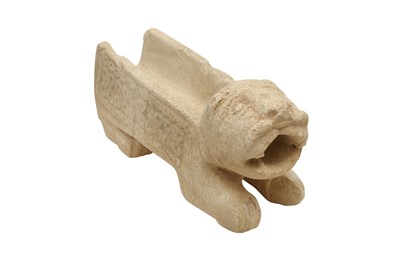28th Oct, 2022 14:00
Islamic & Indian Art
A CARVED WHITE MARBLE SPOUT IN THE SHAPE OF A LION
Al-Andalus, Nasrid Spain, late 14th - 15th century
A CARVED WHITE MARBLE SPOUT IN THE SHAPE OF A LION
Al-Andalus, Nasrid Spain, late 14th - 15th century
Of long narrow rectangular shape, carved on three sides with a central recess, possibly once used as a fountain spout, designed as a squatting lion on four legs, the head carved with thick whiskers, circular eyes, arched eyebrows, and a flattened wide nose, sharp fangs (now truncated) showing on the sides of the circular opening, the outer sides of the lion's body carved with a frieze of four-petalled flower heads within a frame of strapwork, 17.5cm x 36cm x 10cm.
Provenance: Private London collection since the early 1970s.
The material, subject, and function of the present lot can be associated with carved marble zoomorphic sculptures typical of the Nasrid period in Islamic Spain, specifically with the Court of the Lions (Patio de los Leones), the most famous part of the Alhambra compound. Situated in the heart of the historic citadel built in Granada, the construction of the court started in the second period of the Nasrid sultan Muhammad V's reign (1362 - 1391), on the ground formerly occupied by a riyad (patio with garden). The highlight of the patio is a large dodecagon-shaped fountain basin resting on twelve lions made of Macael marble from Almeria, each one carved with naturalistic details. The morphology of their heads is analogous to our example, especially the treatment of the broad flattened nose and wrinkles around the snout and fangs. Beside the size, the main differences between our lot and the Alhambra lions are their standing position and the dimensions of their mouths' openings.
The association of lions with water is strongly rooted in the artistic and architectural vocabulary of Islam, especially in the Mediterranean and Near Eastern provinces of al-Andalus and Syria. The fountain in the Alhambra is perhaps the most celebrated and symbolic visual representation of this bond not only because of its decorative richness, showcasing the pinnacle of Nasrid lapidary art, but also because of its complex hydraulic system, allowing the water to concurrently flow in and out through a system of pipes preventing any spilling. Furthermore, the presence of four converging water channels departing from the base of the fountain denotes a strong symbolic affiliation with Paradise, which in both the Muslim and Christian traditions is described as having four rivers.
Do you have an item similar to the item above? If so please click the link below to submit a free online valuation request through our website.













